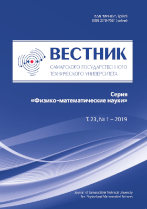|
Mathematical Modeling, Numerical Methods and Software Complexes
Parametric identification of concentrated effects in multidimensional inverse heat conduction problems
A. N. Diligenskaya, I. S. Bochkareva
Samara State Technical University, Samara, 443100, Russian Federation
(published under the terms of the Creative Commons Attribution 4.0 International License)
Abstract:
The study is dedicated to further research and development of constructive methods for sequential parametric optimization of unknown characteristics of nonstationary processes in technological heat physics on a compact set of continuous and continuously differentiable functions. The proposed methodology extends the algorithmically accurate method developed for solving inverse problems in technological heat physics to the multidimensional case of the inverse heat conduction problem, allowing the identification of a physically justified characteristic on sequentially converging compact sets.
The research focuses on a two-dimensional axisymmetric body of canonical shape. The problem is formulated in a uniform metric for assessing the temperature deviation of the calculated state from the experimental one. The mathematical model of the studied object is based on its modal description, which led to the reduction of the original inverse heat conduction problem, formulated in an extremal setting, to an optimal control problem.
The use of preliminary parameterization of the sought-after characteristic of the process results in its representation in the form of piecewise-parabolic functions defined by a parameter vector. The number of considered parameters determines the specific type of approximating function, and their values are found by solving the obtained parametric optimization problem. To solve the mathematical programming problem for optimal parameter vector values, alternating properties of the sought extremals are used, similar to the one-dimensional case, leading to the formulation of a closed system of relationships.
The obtained results demonstrate the effectiveness of extending the constructive method of sequential parametric optimization, tested on one-dimensional inverse heat conduction problems, to solving two-dimensional problems using their modal representation. Increasing the number of parameters of solutions forming the piecewise-parabolic form of the sought dependence leads to a reduction in the reconstruction error of both the sought concentrated function and the spatial-temporal temperature field throughout the domain of spatial variables.
Keywords:
two-dimensional inverse heat conduction problem, parametric optimization, method of successive approximations
Received: February 2, 2024
Revised: March 19, 2024
Accepted: April 29, 2024
First online: October 17, 2024
Citation:
A. N. Diligenskaya, I. S. Bochkareva, “Parametric identification of concentrated effects in multidimensional inverse heat conduction problems”, Vestn. Samar. Gos. Tekhn. Univ., Ser. Fiz.-Mat. Nauki [J. Samara State Tech. Univ., Ser. Phys. Math. Sci.], 28:2 (2024), 286–301
Linking options:
https://www.mathnet.ru/eng/vsgtu2081 https://www.mathnet.ru/eng/vsgtu/v228/i2/p286
|

|




 Contact us:
Contact us: Terms of Use
Terms of Use
 Registration to the website
Registration to the website Logotypes
Logotypes









 Citation in format
Citation in format 